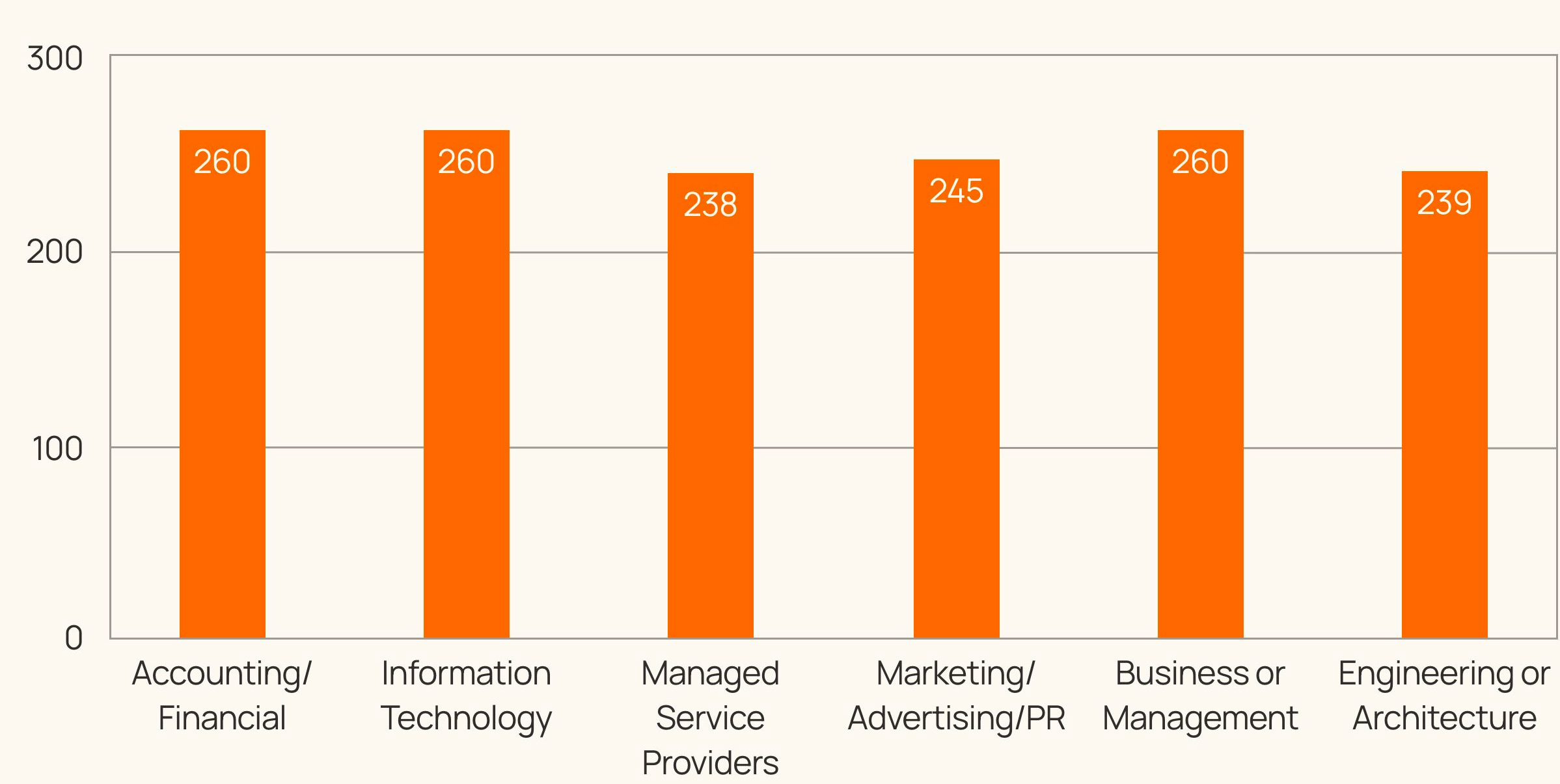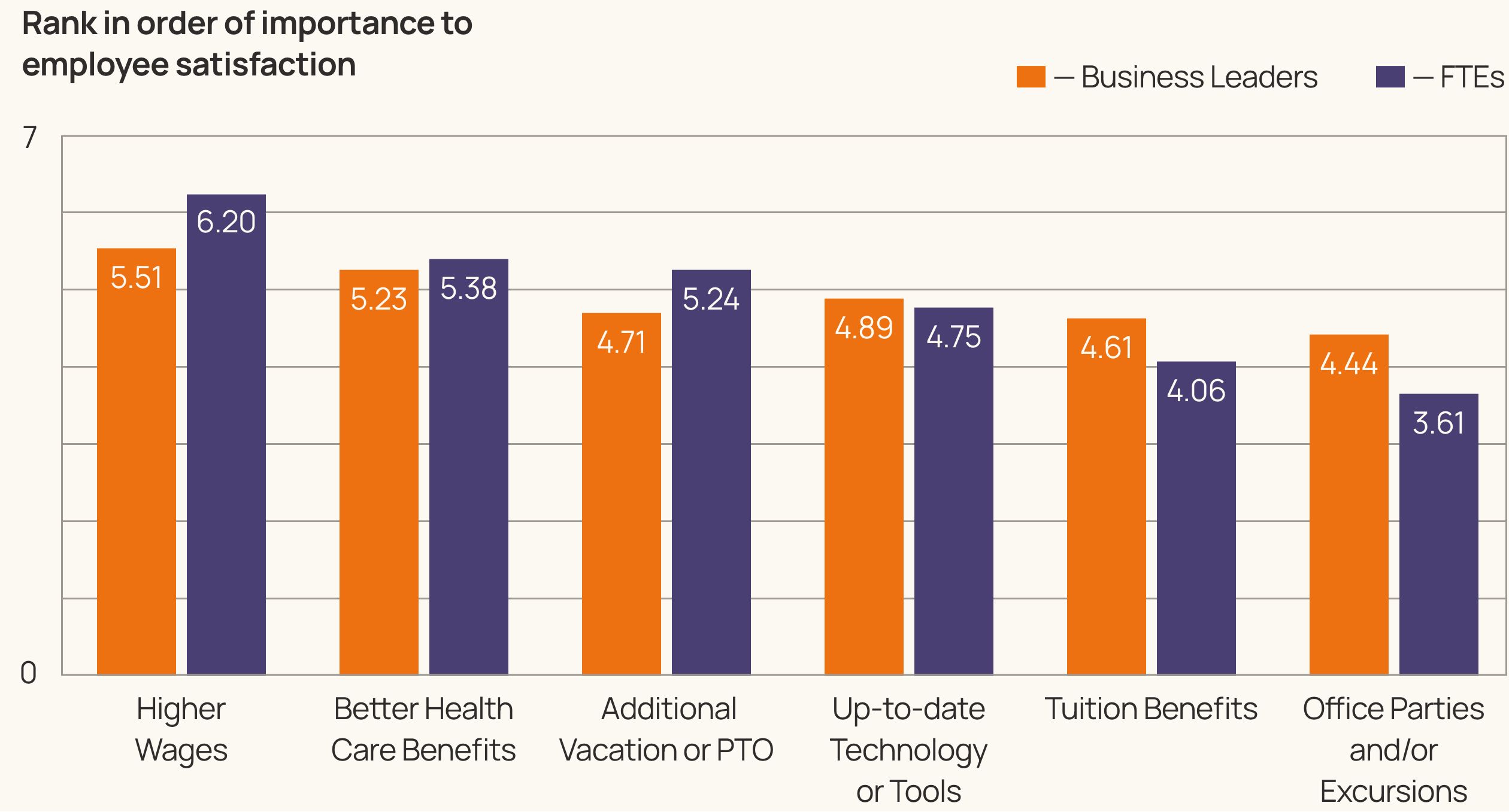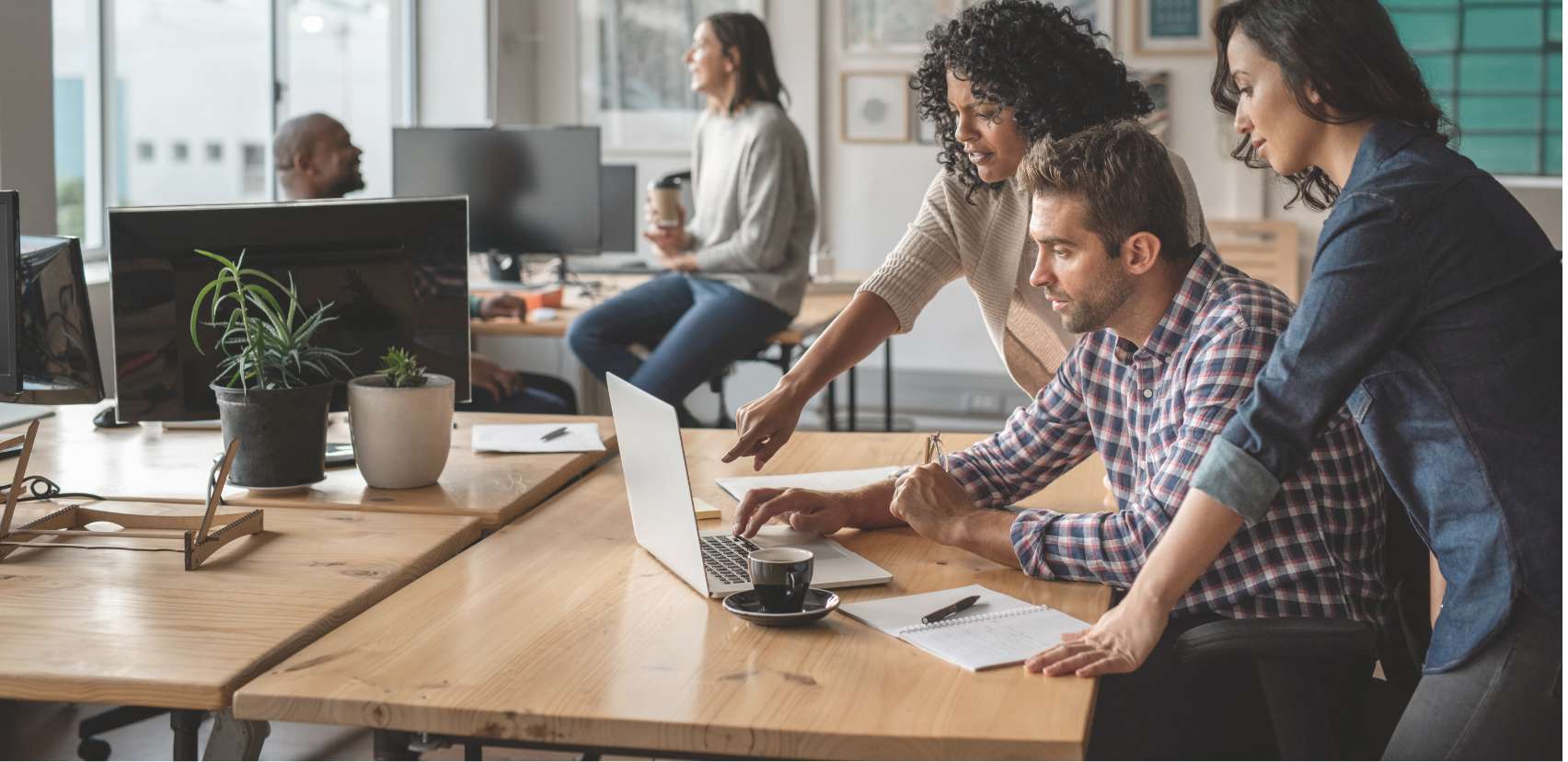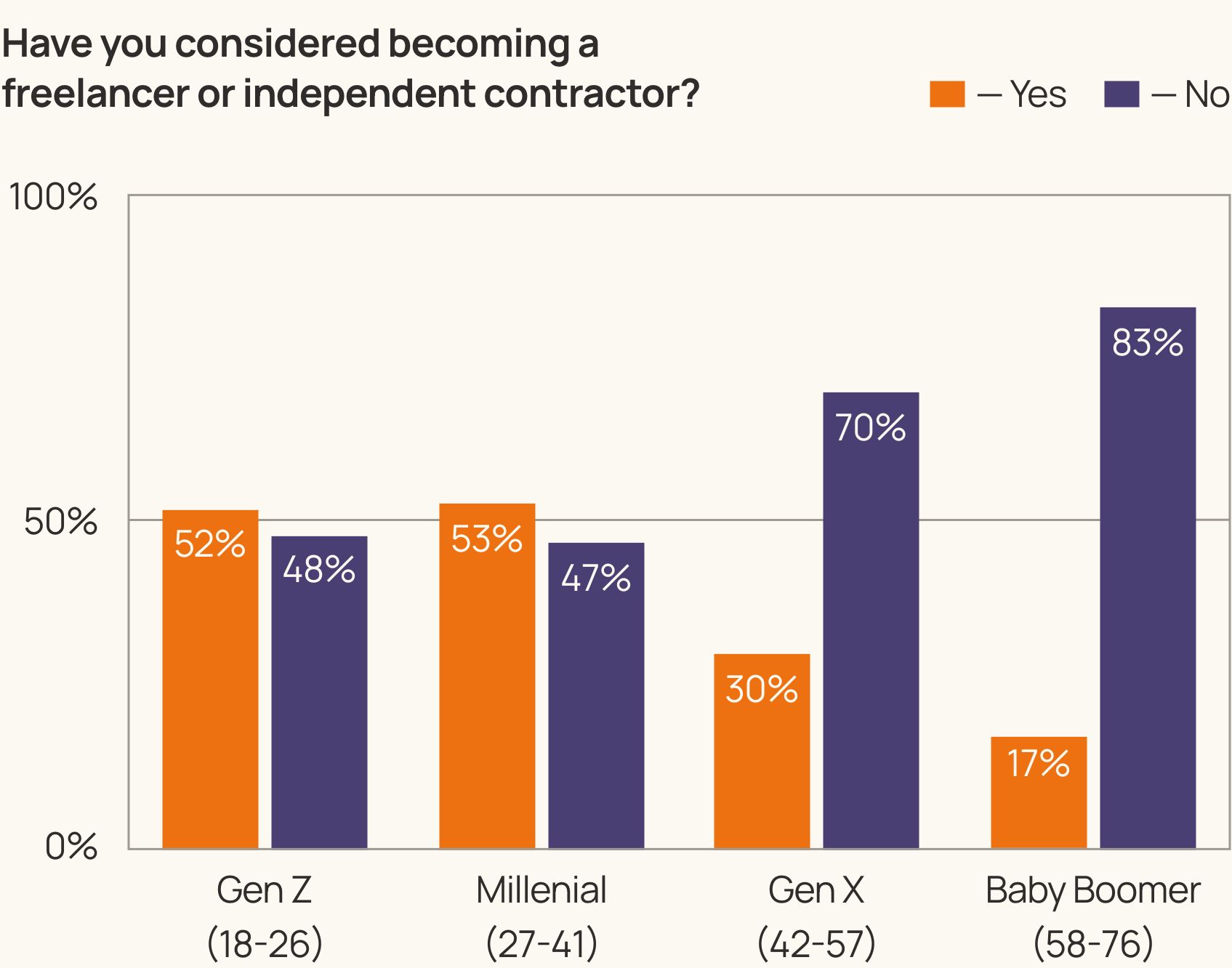The Changing Dynamics of The Modern Workforce
An In-Depth Look at the Professional Services IndustryIntroduction
The professional services industry is undergoing a radical and permanent transformation. People have demonstrated they want more agency over their workloads and professional development, and are taking life-changing steps to realize their goals.
- Business Leaders
- Full-Time Employees
- Independent Contractors
Research Methodology

Business Leaders

61% of senior leadership say they spend at least a third of their time each day trying to solve employee turnover issues, which is pulling focus from core responsibilities like ensuring exceptional client experiences and business development.
And senior leaders aren’t finding it easy to fill the roles that are being vacated either. 53% of senior leadership admit they have a problem hiring full-time employees.
of business leaders spend at least a third of their time each day solving employee turnover issues
of business leaders have a problem hiring FTEs

For senior managers who admit they have a hiring problem, some of the issues they highlighted when it came to closing new FTE hires include:
| Healthcare benefits are not competitive | 42% |
| PTO and vacation policy is hard to accumulate | 42% |
| 401k benefits are not competitive | 39% |
| Lack of a continuing education benefit to support employees’ professional growth | 35% |
The Struggle to Retain and Hire Talent
What keeps employees satisfied
Business leaders and FTEs do agree on what keeps employees satisfied, with both groups ranking Higher Wages as most important, followed by Better Health Care Benefits

Prioritizing Professional Development
FTE INPUT ON TOOLS AND SYSTEMS
PERSPECTIVES ON POST-PANDEMIC CULTURE
Business leaders are much more likely than FTEs to think their company culture has gotten better since the pandemic.

PRODUCTIVITY IN DIFFERENT WORK ENVIRONMENTS
While business leaders and FTEs are in sync on the value of hybrid working, FTEs are more likely to believe productivity is higher when working from home, while business leaders are more likely to believe productivity is higher when working in an office.

Full-Time Employees
Although FTEs and business leaders agree that structured professional development opportunities should be a high priority, a large portion of FTEs said they aren’t seeing the programs that back that belief up - 32% of surveyed FTEs claim they are not sure, or they do not believe, senior leadership prioritizes employees’ professional growth.

When it comes to fighting the rising tide of turnover and implementing strategies that keep valued employees from looking for work elsewhere, factors like technology and professional development opportunities can have major impacts on employee satisfaction and retention.
Employees Are Wondering:
"Should I Stay or Should I Go?"
Considering Freelance Work
The Generation Gap


What's Holding Employees Back
| Benefits (health/dental/vision insurance) concerns | 29% |
| Not sure where to start | 16% |
| Tax ramifications | 10% |
THE ROLE OF TECHNOLOGY
Independent Contractors
Technology is a major reason many people feel confident enough to enter the contractor workforce. The widespread adoption of new technology that supports remote teams is instilling confidence in the long-term viability of remote work. This hasn’t just meant that FTEs are able to work from home more freely, but that the jump to contract work is less intimidating, as 59% of full-time employees believe that the adoption of remote work technology and practices spurred by the pandemic has made the idea of becoming a contractor more appealing.




Independent contractors are also significantly less likely to believe onboarding programs are effective than FTEs. Only 51% of independent contractors say they would rate their company’s onboarding process as effective, a sharp contrast with business leaders and FTEs (83% and 77% respectively).
Contractors Are Struggling to Stay in the Loop
BUSINESS LEADERS PERCEPTIONS
BEHIND THE TECHNOLOGY CURVE
Independent contractors have stronger negative associations with the tools and systems their organizations use than FTEs. Here’s how they describe the tools and systems their organization uses.

BEHIND THE ONBOARDING CURVE
Nearly half of independent contractors would not rate their company’s onboarding processes as effective.

CONTRACTORS NEED PROFESSIONAL DEVELOPMENT OPPORTUNITIES TO STAY AHEAD
Kantata’s Recommendations on How to Build a Modern Workforce
But fear not — these findings also create a roadmap business leaders can follow to reduce churn and accelerate growth. The following steps can help business leaders build a modern workforce where internal and external talent are working in lockstep, with the infrastructure needed to support both their daily work needs and their professional growth desires.
Give Employees and Contractors More Agency
Both FTEs and independent contractors say they would feel more loyal to companies that invest in their professional development goals by paying for development opportunities like certifications, continuing education and masterclasses. Building this loyalty will be a key factor in reducing the impact of churn, ensuring business leaders can spend less of their day struggling with employee turnover and hiring processes.
Structured professional development programs are an essential component of this - over 9 in 10 business leaders and FTEs agree this is true - but don’t discount the value of more informal ways of granting agency to talent, such as providing them a way to “raise their hand” for work that interests them. Publishing open roles to relevant employees and contractors has many benefits - it makes them feel like they have more control over the work they’re doing, it increases opportunities for on-the-job training for people looking to leverage projects as a means of skills acquisition, and it helps resource managers identify resources who would be a great fit for a role but who might otherwise slip through the cracks.
Include Your Workforce in Decision-Making
The benefits of building a more structured process for getting feedback and buy-in from the people who will be expected to use new tools and systems are two-fold. Providing a forum for feedback, questions, and concerns doesn’t just ensure talent feels heard; it also makes businesses less likely to adopt solutions that will not meet the needs of their users.
Opening up conversations with your employees and contractors about what they need, what they want, and what they feel is holding them back will help business leaders make informed decisions and improve the overall satisfaction of their talent network.
Audit Compensation and Benefits Packages
It is important for every business to audit their compensation and benefits practices to ensure that they are competitive and will be attractive to both existing and new talent. If those practices and standards are not meeting or exceeding the standards of the industry, businesses stand to lose more from the missed opportunities that come with high turnover and ineffective hiring than the cost of adjusting compensation and benefits packages.
Make It Easier for Talented Contractors to Work With Your Business
With all that in mind, every business needs to be equipped to work effectively with contractors and freelancers. Our research shows clear gaps in contractors’ perceptions of the technology and onboarding processes they are being provided. External talent can often be an afterthought when it comes to technology strategies and process optimization, but they can’t be an afterthought going forward if businesses hope to thrive in the networked economy.
For businesses to build a stable bench of contractors that they can rely on to provide high quality work, that trust needs to go both ways - external team members need to feel that they can rely on businesses to offer them access to technology and processes that keep them on the same footing as internal team members. If they don’t trust that that will be true, they will use the freedom that independence affords to look for work elsewhere.
Implement Purpose-Built Technology
Only the best providers of professional services software are able to equip their clients with the solutions and expertise they need to stay ahead of shifting talent demands while efficiently and effectively managing their operations. The vendors that lead the charge into a new era of professional services technology will have the specialized focus and domain expertise to understand the evolving challenges professional services organizations face, as well as the scale to translate those challenges into ground-breaking solutions.
The businesses that adopt software that is purpose-built for the professional services industry will have a competitive advantage, and an advantage in the fight to attract and retain the best talent. FTEs and independent contractors need purpose-built software to maximize productivity and streamline collaboration so that they can be more effective in their roles and more likely to thrive in their careers. And business leaders gain invaluable short- and long-term visibility into the insights and key performance indicators they need to improve resource management, shorten business development cycles, and build their optimal talent network.